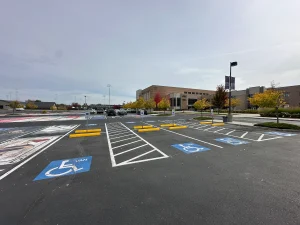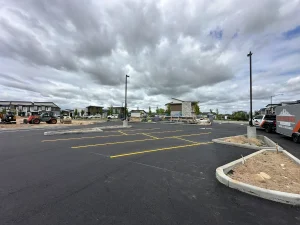Property Management 101: When Does a Parking Lot Need Asphalt Repairs or Replacement?
As a property manager, you’re responsible for keeping the exterior of your commercial property safe, accessible, and visually appealing—and that includes your parking lot. Over time, even well-constructed asphalt surfaces will degrade due to traffic, weather, and age. But how can you tell when it’s time for routine asphalt maintenance versus a complete replacement?
Understanding the early warning signs and knowing when to act can save thousands of dollars and prevent safety issues down the road. Here’s a guide to help you assess the condition of your parking lot and determine what kind of asphalt work is needed.
1. Cracks Are Spreading
Cracks are one of the most common early indicators that your asphalt surface is starting to deteriorate. Not all cracks are created equal, though.
- Hairline cracks can often be sealed or filled as part of routine maintenance.
- Alligator cracking, which looks like the skin of a reptile, indicates structural failure beneath the surface. This usually requires patching or full-depth repairs.
If you notice widening or interconnected cracks, it’s time to call a commercial asphalt contractor for an evaluation.
2. Standing Water After Rain
After a rainstorm, does water pool in certain areas of the lot? Poor drainage is more than a nuisance—it’s a sign that the asphalt may be sinking, warping, or that the slope of the lot is incorrect.
- Water accelerates asphalt degradation by seeping into cracks and weakening the base.
- If not corrected, pooling water can lead to potholes or even foundation damage.
Professional asphalt resurfacing or regrading may be necessary to correct drainage problems.
3. Fading and Surface Wear
Over time, UV rays and vehicle traffic cause the rich black color of asphalt to fade into a dull gray. While this may seem like a cosmetic issue, it often signals oxidation and surface wear.
- Faded asphalt loses its ability to repel water.
- If left untreated, small surface flaws can develop into major structural problems.
Sealcoating every 2–3 years is a cost-effective way to protect your pavement and restore its appearance.
4. Potholes and Uneven Areas
Potholes are a clear sign that your asphalt is deteriorating—and they pose a serious safety and liability risk.
- If your lot has one or two potholes, they may be repaired with asphalt patching.
- However, if potholes are widespread, it’s a sign of underlying base failure and may require full asphalt replacement.
Ignoring potholes can lead to vehicle damage, trip-and-fall accidents, and increased repair costs.
5. Age of the Pavement
If your parking lot is over 15–20 years old, it’s likely nearing the end of its usable life—even if there are no major surface issues yet.
- Regular inspections can help you anticipate repairs and plan a capital improvement budget.
- A full asphalt overlay or replacement may be the most cost-effective long-term solution.
Final Thoughts: When to Call a Professional
Not every parking lot problem requires full replacement, but ignoring early warning signs can lead to larger, more expensive issues. Here at Rocky Mountain Services, we are a trusted asphalt contractor that can inspect your lot, identify problem areas, and recommend the right mix of maintenance, repairs, or replacement.
By staying proactive, property managers can extend the life of their asphalt, improve safety, and protect the property’s value.


